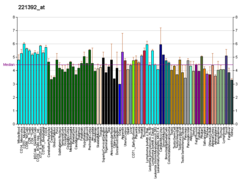TAS2R4
ظاهر
گیرندهٔ چشایی نوع ۲، عضو ۴ (انگلیسی: Taste receptor type 2 member 4) یک پروتئین است که در انسان توسط ژن «TAS2R4» کُدگذاری میشود.[۴][۵][۶]
این ژن و پروتئینش در حسِ چشایی در انسان و شناخت مزه تلخی نقش دارند.
منابع
[ویرایش]- ↑ ۱٫۰ ۱٫۱ ۱٫۲ GRCm38: Ensembl release 89: ENSMUSG00000037140 - Ensembl, May 2017
- ↑ "Human PubMed Reference:". National Center for Biotechnology Information, U.S. National Library of Medicine.
- ↑ "Mouse PubMed Reference:". National Center for Biotechnology Information, U.S. National Library of Medicine.
- ↑ Adler E, Hoon MA, Mueller KL, Chandrashekar J, Ryba NJ, Zuker CS (Apr 2000). "A novel family of mammalian taste receptors". Cell. 100 (6): 693–702. doi:10.1016/S0092-8674(00)80705-9. PMID 10761934.
- ↑ Chandrashekar J, Mueller KL, Hoon MA, Adler E, Feng L, Guo W, Zuker CS, Ryba NJ (Apr 2000). "T2Rs function as bitter taste receptors". Cell. 100 (6): 703–11. doi:10.1016/S0092-8674(00)80706-0. PMID 10761935.
- ↑ "Entrez Gene: TAS2R4 taste receptor, type 2, member 4".
- مشارکتکنندگان ویکیپدیا. «TAS2R4». در دانشنامهٔ ویکیپدیای انگلیسی، بازبینیشده در ۴ اکتبر ۲۰۱۸.
بیشتر بخوانید
[ویرایش]- Kinnamon SC (2000). "A plethora of taste receptors". Neuron. 25 (3): 507–10. doi:10.1016/S0896-6273(00)81054-5. PMID 10774719.
- Margolskee RF (2002). "Molecular mechanisms of bitter and sweet taste transduction". J. Biol. Chem. 277 (1): 1–4. doi:10.1074/jbc.R100054200. PMID 11696554.
- Montmayeur JP, Matsunami H (2002). "Receptors for bitter and sweet taste". Curr. Opin. Neurobiol. 12 (4): 366–71. doi:10.1016/S0959-4388(02)00345-8. PMID 12139982.
- Firestein S (2000). "The good taste of genomics". Nature. 404 (6778): 552–3. doi:10.1038/35007167. PMID 10766221.
- Matsunami H, Montmayeur JP, Buck LB (2000). "A family of candidate taste receptors in human and mouse". Nature. 404 (6778): 601–4. doi:10.1038/35007072. PMID 10766242.
- Ueda T, Ugawa S, Ishida Y, Shibata Y, Murakami S, Shimada S (2001). "Identification of coding single-nucleotide polymorphisms in human taste receptor genes involving bitter tasting". Biochem. Biophys. Res. Commun. 285 (1): 147–51. doi:10.1006/bbrc.2001.5136. PMID 11437385.
- Zhang Y, Hoon MA, Chandrashekar J, Mueller KL, Cook B, Wu D, Zuker CS, Ryba NJ (2003). "Coding of sweet, bitter, and umami tastes: different receptor cells sharing similar signaling pathways". Cell. 112 (3): 293–301. doi:10.1016/S0092-8674(03)00071-0. PMID 12581520.
- Fischer A, Gilad Y, Man O, Pääbo S (2005). "Evolution of bitter taste receptors in humans and apes". Mol. Biol. Evol. 22 (3): 432–6. doi:10.1093/molbev/msi027. PMID 15496549.
- Go Y, Satta Y, Takenaka O, Takahata N (2006). "Lineage-Specific Loss of Function of Bitter Taste Receptor Genes in Humans and Nonhuman Primates". Genetics. 170 (1): 313–26. doi:10.1534/genetics.104.037523. PMC 1449719. PMID 15744053.



